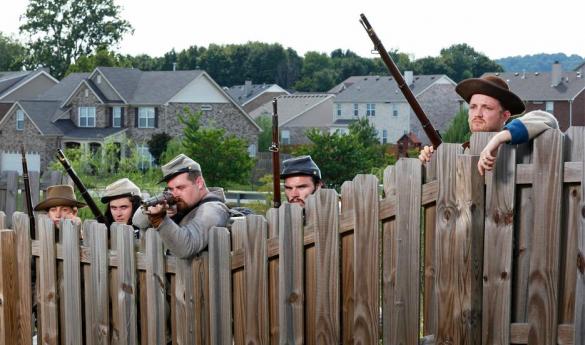State of the Union: Juxtaposition of past and present
“Photography is a way of collecting. It is the ultimate ideal of nostalgia.” That’s exactly how California-based photographer Gregg Segal sums up the focus of his work Segal’s set of photographs titled “State of the Union” contrasts two distinct eras of an “idealized Civil War embodied by Civil War reenactors versus the commercialism of contemporary life,” as detailed on his website. Segal’s photography is currently on display until October 1 in the Mason Hall atrium through Mason’s School of Art.
Segal’s work focuses on the juxtaposition between our past and present, placing Civil War reenactors into battle sites that have been "compromised by sprawl, overrun by freeway expansion, housing developments, shopping malls and all other hastily erected constructs of consumer life.” Images such as one featuring a Civil War reenactor entrenched making a tough decision about what to eat at a buffet line is an example of how Segal contrasts the past with the modern world.
The images look as though the Civil War reenactors are just plopped into images of our everyday lives. One image casts the reenactors in an everyday suburban housing development that provides the backdrop as five soldiers peer over a high fence. Another image focuses on a soldier walking under a highway overpass as if he is lost in battle searching for the rest of his troops.

For this project, Segal had help from Tony Horwitz, author of “Confederates in the Attic,” who served as his guide and as the inspiration for the collection. Segal also worked with Civil War reenactor Robert Hodge who is featured in several of the photographs. Hodge accompanied Segal by pointing out different places to shoot and became a walking encyclopedia, a trait that led to the discovery that both had, “very clear ideas and similar interests in the conservation of the past,” Segal stated. Hodge guided Segal throughout his many trips to parts of Pennsylvania, Virginia, Georgia and Kentucky.
What is most remarkable about Segal’s work is that the viewer has a real connection to the photographs. When we learn about history we are always several steps removed from it. However, the images that are the focus of Segal’s work are places that we are familiar with.

In one particular photograph a soldier ready for battle, staked out on top of a shoveled pile of snow in a Staples store parking lot in Fredricksburg, Va.
“I know that store. I know that parking lot,” said Stephanie Booth, head of Focus Group, Mason’s photography club. A simple parking lot or a suburban neighborhood are images from our everyday lives that, without us realizing it, used to be a part of history.
Images shot in Fredricksburg, Va.,Booth’s hometown, she sees are a real reflection of, “Fredericksburg’s issue with having one foot in the past and the other in the present.”
For Segal, nostalgia and its placement in the past and present is not something new. Segal said he has always had a natural affinity for taking photographs as a way “of ordering the world and giving it parameters… a way of collecting a phobia of time passing.”
Nostalgia is a consistent theme in Segal’s work, reflected in his 2006 set of photographs entitled “Super Heroes.” Photos from this set are also included as a separate mini gallery next to “State of the Union” in Mason Hall. Here, Segal’s work focuses on what people anticipate when they visit Hollywood, where he says “tourists expect to find the Hollywood they've seen in the movies as they make their way to Grauman's Chinese Theater but instead are greeted by costumed entertainers.”
Some of these entertainers include individuals masquerading as Batman and Superman for tourists to take pictures with. For many of these performers, who had hopes of making it big in Hollywood, dressing up a superhero as freelance work is “maybe as close as they come to realizing their dreams.”
In his 2006 work, Segal followed these super heroes as they lived their everyday lives, following them home to “highlight the contrast of the fantastic and mundane.” Segal photographed Superman, a childhood icon for most, vacuuming with a cigarette dangling from his lower lip all decked out in his costume. Another image shows Superman cleaning out the toilet nealing down and holding a can of powdered Comet bowl cleaner.

Still another image focuses on Superman hanging up his laundry followed by another of Captain America checking his mail. Like the images from “State of the Union,” these photographs deal with the juxtaposition of past and present meeting as Segal stated a “jarring reflection of our time.”
Both collections focus on heroes; those from our past and those still present in our pop culture, commenting on the “alternative identity of the hero versus the mundane.”
To see more of Gregg Segal's work, including other collections of his photography visit Gregg Segal's website. All images used are courtesy of Gregg Segal.

